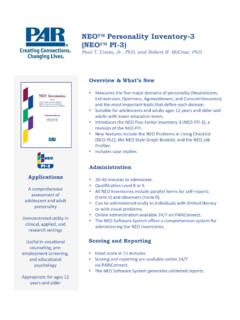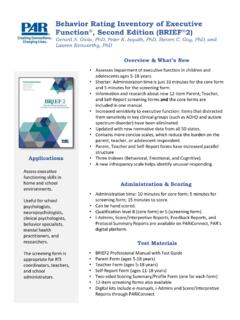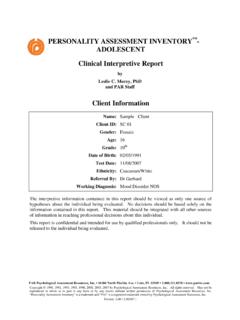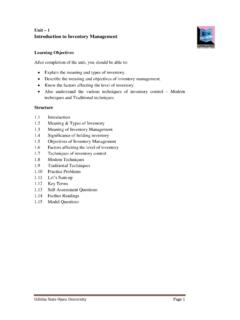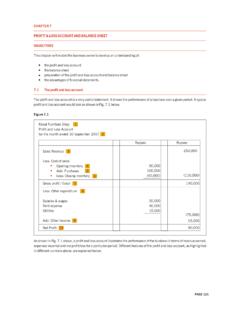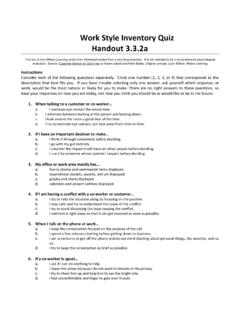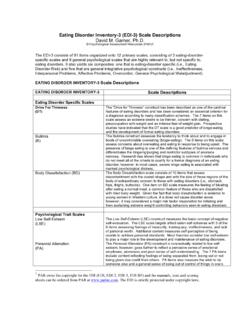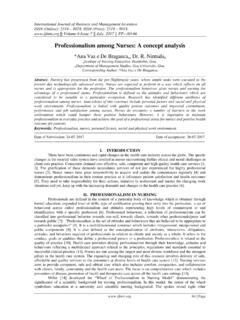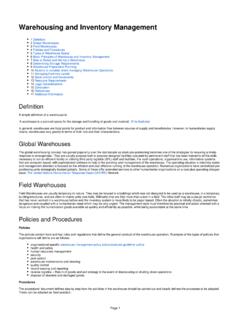Transcription of Personality Assessment Inventory™ - PAR, Inc
1 Personality Assessment inventory Clinical Interpretive Reportby Leslie C. Morey, PhD and PAR StaffGenerated byClient name :Sample ClientClient ID :4321 Age :24 Gender :MaleEducation :12 Marital status :SingleTest date :05/13/2013 The interpretive information contained in this report should be viewed as only one source of hypotheses about the individual being evaluated. No decisions should be based solely on the information contained in this report. This material should be integrated with all other sources of information in reaching professional decisions about this report is intended for use by qualified professionals only and is not to be shared with the examinee or any other unqualified persons.
2 16204 N. Florida Ave. | Lutz, FL 33549 | | Assessment inventory copyright 1989, 1990, 1991 by PAR. All rights reserved. PAI Plus Clinical Interpretive Report copyright 1990, 1991, 1993, 1995, 1998, 2000, 2008, 2020 by PAR. All rights reserved. May not be reproduced in whole or in part in any form or by any means without written permission of PAR. Personality Assessment inventory is a trademark and PAI is a registered trademark owned by : VALIDITY SCALES INDICATE HYPOTHESES MAY NOT BE Scale Profile with Motor Vehicle Accident Claimants Profile OverlaySubscale Profile with Motor Vehicle Accident Claimants Profile OverlayAlternative Model for Personality Disorders ProfileNIM/PIM-Specific Full Scale and Subscale ProfilesAdditional Profile InformationValidity of Test ResultsClinical FeaturesSelf ConceptInterpersonal and Social EnvironmentTreatment ConsiderationsDSM-5 Diagnostic PossibilitiesCritical Item EndorsementPAI Item ResponsesFull Scale Profile with Additional Profile Overlays Subscale Profile with Additional Profile
3 Overlays PAI Plus Clinical Interpretive Report | Sample Client (4321) | 05/13/2013 | Page 2 WARNING: VALIDITY SCALES INDICATE HYPOTHESES MAY NOT BE Scale Profile with Motor Vehicle Accident Claimants Profile OverlayPlotted T scores are based upon a Census-matched standardization sample of 1,000 normal adults. indicates the score is more than two standard deviations above the mean for a sample of 1,246 clinical patients. indicates the scale has more than 20% missing Plus Clinical Interpretive Report | Sample Client (4321) | 05/13/2013 | Page 3 WARNING: VALIDITY SCALES INDICATE HYPOTHESES MAY NOT BE Profile with Motor Vehicle Accident Claimants Profile OverlayMissing Items = 0 Plotted T scores are based upon a Census-matched standardization sample of 1,000 normal adults.
4 Indicates the score is more than two standard deviations above the mean for a sample of 1,246 clinical patients. indicates the scale has more than 20% missing Plus Clinical Interpretive Report | Sample Client (4321) | 05/13/2013 | Page 4 WARNING: VALIDITY SCALES INDICATE HYPOTHESES MAY NOT BE Model for Personality Disorders ProfilePlotted T scores are based upon a Census-matched standardization sample of 1,000 normal Plus Clinical Interpretive Report | Sample Client (4321) | 05/13/2013 | Page 5 WARNING: VALIDITY SCALES INDICATE HYPOTHESES MAY NOT BE Full Scale and Subscale ProfilesFull Scale ProfileSubscale ProfilePAI Plus Clinical Interpretive Report | Sample Client (4321) | 05/13/2013 | Page 6 WARNING.
5 VALIDITY SCALES INDICATE HYPOTHESES MAY NOT BE Profile InformationSupplemental PAI IndicesNegative Distortion IndicatorsRaw valueT scoreMalingering Index044 Rogers Discriminant Distortion Scale*449 Hong Malingering Index* Feigning Index*N/A39 Malingered Pain-Related Disability Discriminant Function* Distortion IndicatorsRaw valueT scoreDefensiveness Index670 Cashel Discriminant Distortion Scale*4164 Hong Defensiveness Index* Distortion IndicatorsRaw valueT scoreBack Random Responding1665 Hong Randomness Index* Clinical IndicatorsRaw valueT scoreSuicide Potential Index040 Violence Potential Index147 Treatment Process Index255 ALC Estimated ScoreN/A47 (Equal to ALC)DRG Estimated ScoreN/A44 (2T higher than DRG)Mean Clinical ElevationN/A40 Inattention (INATTN) Index*156 Neuro-Item Sum*037 Violence and Aggression Risk Index*039 Reactive Aggression Scale*937 Instrumental Aggression Scale*2154 Level of Care Index*142 Chronic Suicide Risk (S_Chron) Index*133 RXR Estimated Score*N/A54 (7T lower than RXR)Note: Experimental indices are denoted with an asterisk (*) and italicized text.
6 They should be interpreted with caution because of the limited cross-validation research. --- indicates the value could not be calculated due to missing Plus Clinical Interpretive Report | Sample Client (4321) | 05/13/2013 | Page 7 WARNING: VALIDITY SCALES INDICATE HYPOTHESES MAY NOT BE Profile Information (continued)Coefficients of fit with profiles of known clinical groupsDiagnostic GroupsCoefficient of fitUnspecified somatic symptom and related use I disorder (mania) use Personality depressive stress Personality depressive disorder (dysthymia) Cluster ProfilesCoefficient of fitCluster Behavior GroupsCoefficient of fitSpouse of (paranoid) : Coefficients above a value of.
7 42 represent statistically significant associations between Plus Clinical Interpretive Report | Sample Client (4321) | 05/13/2013 | Page 8 WARNING: VALIDITY SCALES INDICATE HYPOTHESES MAY NOT BE Profile Information (continued)Coefficients of fit with profiles of known clinical groupsResponse Set GroupsCoefficient of fitFake predicted predicted "false" "very true" "mainly true" "slightly true" Norm GroupsCoefficient of fitEgg donors and gestational kidney enforcement officer custody surgery pain vehicle accident : Coefficients above a value of .42 represent statistically significant associations between of Test ResultsThe PAI provides a number of validity indices that are designed to provide an Assessment of factors that could distort the results of testing.
8 Such factors could include failure to complete test items properly, carelessness, reading difficulties, confusion, exaggeration, malingering, or defensiveness. For this protocol, the number of uncompleted items is within acceptable evaluated is the extent to which the respondent attended appropriately and responded consistently to the content of test items. The respondent's scores suggest that he did attend appropriately to item content and responded in a consistent fashion to similar degree to which response styles may have affected or distorted the report of symptomatology on the inventory is also assessed.
9 Certain of these indicators fall outside of the normal range, suggesting that the respondent may not have answered in a completely forthright manner; the nature of his responses might lead the evaluator to form a somewhat inaccurate impression of the client based upon the style of responding described below. With respect to positive impression management, the PAI Plus Clinical Interpretive Report | Sample Client (4321) | 05/13/2013 | Page 9 WARNING: VALIDITY SCALES INDICATE HYPOTHESES MAY NOT BE 's pattern of responses suggests considerable defensiveness in responding. In particular, he appears motivated to portray himself as being exceptionally free of common shortcomings to which most individuals will admit.
10 As a result, he will be quite reluctant to admit to minor faults, perhaps not even willing to admit these faults to himself. Accompanying this reluctance may be a tendency to minimize any negative impact that his actions may have on other people, and also on himself. Given the high level of defensiveness, the clinical scale profile is likely to reflect significant distortion and minimization of difficulties in certain areas, and the professional should review the test results with this in mind. Regardless of the cause, THE TEST RESULTS ARE UNLIKELY TO BE A VALID REFLECTION OF THE RESPONDENT'S EXPERIENCE THE FOLLOWING INTERPRETATION IS PROVIDED ONLY AS AN INDICATION OF THE RESPONDENT'S the level of defensiveness noted above, there are some areas where the client described problems of greater intensity than is typical of defensive respondents.
